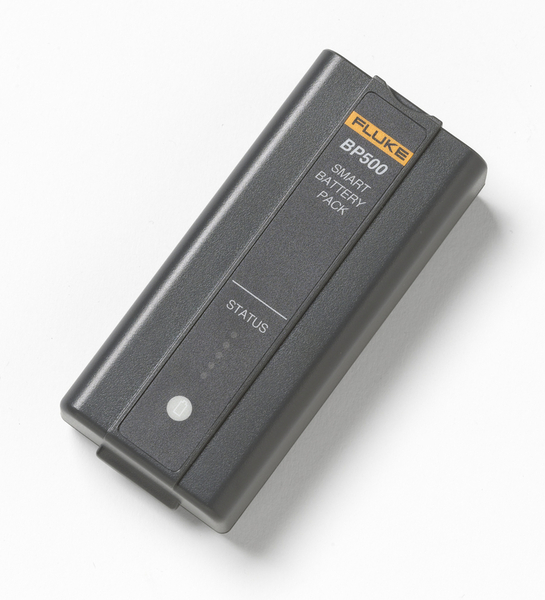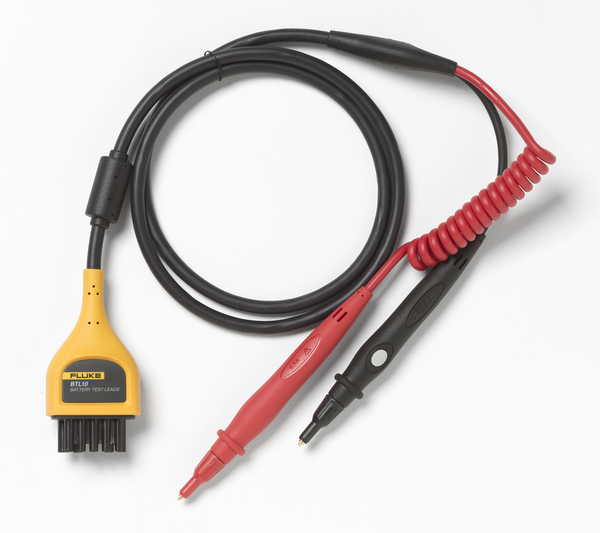Fluke BT520 Description
The Fluke BT520 Battery Analyzer is supplied with Fluke’s Interactive Test Probe set that also includes probe extensions this is designed specifically for the UPS Service Engineers so that they can view the test results via the probes integrated display test results can be saved automatically or via the integrated test button. The Fluke BT520 Battery Analyzer covers the key measurement and recording requirements for monitoring UPS battery systems including the simultaneous measurement of battery resistance and voltage. Another UPS test feature is the ability to record discharge voltage for each battery cell during discharge testing and here you are able to record up to 8 test rounds. These can later be viewed via the Fluke BT520 or downloaded and viewed in a report as a table or graph. The Fluke BT520 Battery Analyzer also offers multimeter functions for other UPS system measurements such as AC/DC voltage up to 600V and the measurement of AC ripple voltage for the monitoring the battery charging system.
The Fluke BT520 allows you to create a test profiles, recording details such as the Site Name, UPS Location, UPS Number, String Number, Number of Batteries, Battery Start ID, Battery Type and Capacity. Once your tests are complete the recorded profile and test data can be downloaded into a simple test report including test result table and bar chart if required.
This special profile recording procedure can really save time, up to 100 test profiles can be stored on the Fluke BT520 Battery Analyzers internal memory to be recalled the next time you visit the same site.
The Fluke BT520 assess the health of both valve regulated and flooded lead acid batteries, whether it’s at the point of sale verifying the quality of a new battery or in the hands of service engineers checking UPS battery banks. It confirms the batteries internal impedance and terminal voltage, two important conditions that verify the condition of the battery and thus its ability to do its job! Batteries that form part of a UPS system can be inspected with the Fluke BT520 Portable UPS Battery Analyzer without having to disconnect the batteries from the system that they protect. Batteries can even be tested while connected to the charging circuit. With the Fluke BT520 Battery Analyzer both the battery resistance and voltage are measured simultaneously; readings are automatically held and stored to the instruments integral memory which is capable of storing up to 450 battery tests in each of the 100 separate profile locations. Test results are stored against real time; this feature enables UPS service engineers to work without constraint for many days/weeks before it is necessary to download test data.
‘Positive Grid Corrosion’ is the normal battery failure mode and results in a steady increase in the batteries resistance, the Fluke BT520 Battery Analyzer is ideal for detecting this common fault. Other more induced faults can also be detected; these would include ‘Plate Sulphation’ due to inadequate charging conditions and ‘Dry-out’ the result of excessive heat from either over charging or high ambient temperatures.
Another form of UPS battery monitoring is to employ battery load bank testing, its time consuming, expensive and takes the UPS system off line but when it comes to fully understanding your battery system its sometimes the best choice and helps you monitor and evaluate the performance of the complete UPS battery system. But we would suggest that before a load test is carried out on a bank or string of batteries it’s important to still test all of the batteries within the bank/string individually. This will at least establish that they are safe and potentially able to support the load test. The load test should at least replicate the potential ‘real’ load that needs to be supported. While load testing its worth monitoring each battery cell and for this you can use the Fluke BT520 Battery Analyzers discharge voltage test sequence. Battery faults can develop during or after the load test and with the aid of the Fluke BT520 Battery Analyzer you will be able to find faulty battery cells that might not have been found if each individual battery cell had not been monitored during discharge.










